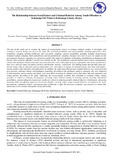| dc.contributor.author | Otte, Zebedee Ekwenye | |
| dc.contributor.author | Simiyu, Ruth Naliaka | |
| dc.date.accessioned | 2023-12-07T15:08:53Z | |
| dc.date.available | 2023-12-07T15:08:53Z | |
| dc.date.issued | 2023-11-27 | |
| dc.identifier.uri | https://doi.org/10.51867/ajernet.4.2.129 | |
| dc.identifier.uri | https://ajernet.net/ojs/index.php/ajernet/article/view/230 | |
| dc.identifier.uri | http://ir-library.mmust.ac.ke:8080/xmlui/handle/123456789/2473 | |
| dc.description.abstract | The aim of this study was to examine the impact of socioeconomic factors on teenage criminal conduct. A descriptive and evaluative research design was used in the study. We used both probability and non-probability sampling approaches. Non-probability sampling included deliberate and convenient sampling, whereas probability sampling included proportionate stratified random sampling. Both probabilistic and non-probabilistic sampling strategies were used to pick the sample for the investigation. Purposive sampling was utilized to identify 200 adolescent offenders undertaking rehabilitation at Kakamega GK Prison, where previous offenders' records were already on file. The quantitative research method used a survey questionnaire, whereas the qualitative method used semi-structured interviews with a subsample of survey respondents. The survey and interview data were analyzed using descriptive statistics and thematic analysis, respectively. The findings found that juveniles from low-income homes with no education and no employment were more likely to engage in criminal activity than those from higher-income families with education and employment. In addition, the study found that juvenile criminal behavior was associated with peer pressure, substance misuse, and inadequate parenting. According to the qualitative analysis, teenagers who were subjected to bad parenting, such as neglect and abuse, were more likely to engage in criminal activity than those who had supportive and caring parents. According to the study, addressing the socioeconomic variables that contribute to criminal conduct among juveniles is critical to reducing the frequency of young crime. Policies aiming at lowering poverty, boosting educational possibilities, and providing job prospects for youths are critical to reducing juvenile criminal behavior. Furthermore, enhancing parenting skills and offering support to low-income families can help reduce young criminal behavior. According to the study, governments, community leaders, and parents must collaborate to offer the necessary assistance and resources to ensure that adolescents in low-income communities do not fall behind. | en_US |
| dc.language.iso | en | en_US |
| dc.publisher | AFRICAN JOURNAL OF EMPIRICAL RESEARCH | en_US |
| dc.subject | Relationship, Social Factors, Criminal, Behavior, Youth, Offenders, GK, Prison County, | en_US |
| dc.title | The Relationship between Social Factors and Criminal Behavior Among Youth Offenders in Kakamega GK Prison in Kakamega County, Kenya | en_US |
| dc.type | Article | en_US |

